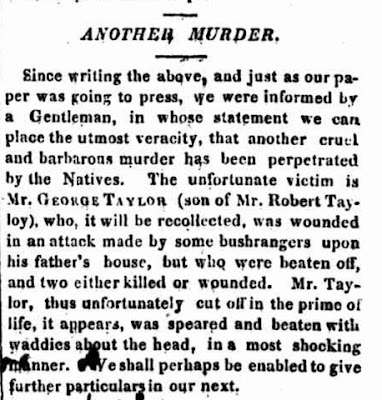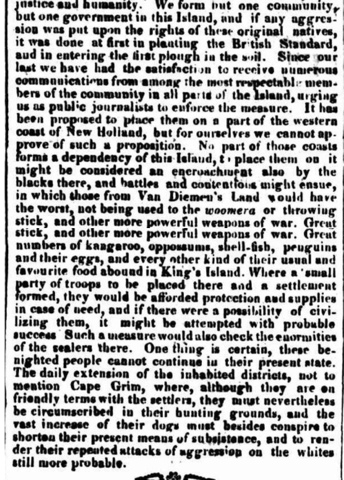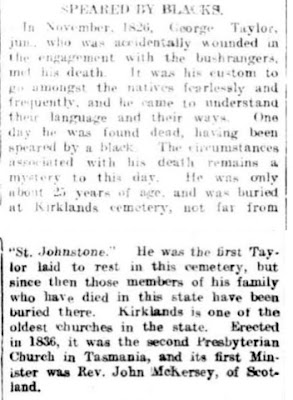This week’s Sepia Saturday prompt photograph has men sitting at long tables for a formal dinner. This reminded me of a painting by my fourth great aunt, Martha Berkeley née Chauncy (1813 – 1899), sister of Philip Chauncy (1816 – 1880), my third great grandfather.
Martha arrived in Adelaide South Australia in February 1837 on the John Renwick with her husband and her unmarried sister Theresa (1807 – 1876). They landed just six weeks after the Proclamation of the Province on 28 December 1836 when, by Vice-regal proclamation, South Australia was established as a British province
Martha was an artist. Several of her works are held by the Art Gallery of South Australia. One of the more notable is a watercolour of The first dinner given to the Aborigines 1838.

Berkeley Martha, The first dinner given to the Aborigines 1838, Art Gallery of South Australia
A notice appeared in the South Australian Gazette and Colonial Register on October 27 announcing a conference with the Aborigines of the Province with a dinner to be given to them.

Advertising. (1838, October 27). South Australian Gazette and Colonial Register (Adelaide, SA : 1836 – 1839), p. 1. Retrieved from http://nla.gov.au/nla.news-article31750198
Martha’s watercolour was:
Her major work … a large watercolour, The First Dinner Given to the Aborigines (AGSA), depicting the three Adelaide tribes being entertained by Governor Gawler on 1 November 1838. The Aborigines sit awaiting the distribution of biscuits, meat, tea and blankets, while their three chiefs, dressed in new jackets provided by the settlers, stand together at the inner edge of the circle surrounding the Governor, the Protector of Aborigines and their wives. Behind the Aborigines is a standing ring of settlers, which includes obvious portraits. Berkeley added a pencil description of the event on the back of the painting in 1847, which confirms her aim of recording an important historical event for posterity. (Kerr, Joan. “Martha Maria Snell Berkeley.” Design & Art Australia Online. Design & Art Australia Online retrieved from http://www.daao.org.au/bio/martha-maria-snell-berkeley/biography/ )
This description aligns with a newspaper account of the event in the Southern Australian of 3 November 1838.
THE ABORIGINES.—On Thursday last, in pursuance of an advertisement issued by the Governor, a dinner was given to the natives, and the occasion excited much interest in the town. Soon after the hour appointed for the assembling, a vast concourse of the inhabitants had collected on the ground, and were enjoying the fineness of the weather in promenading for upwards of two hours before the ceremonies commenced.
About two o’clock a band of about 160 natives were assembled, and their appearance was certainly highly pleasing and orderly ; their huzzas would have done great credit to the lungs and voices of English-men, and their general, demeanour upon the occasion was very orderly. The native men were dressed in gaudy coloured cottons and the women had new blankets and rugs; and the tout ensemble of the group had a very striking effect.
Soon after they arrived, His Excellency said a few words, which were translated by Mr. WYATT, expressive of his desire that they should imitate the good qualities of the whites, learn to fear and love God, learn English, cease from quarrels with each other, and pay respect to the property of the whites.— Whether they understood what was said, we know not, but the vacant stare and senseless faces of many evidently bespoke utter ignorance of the meaning of His Excellency.
Immediately after, they squatted on the ground in a series of groups, and were regaled with roast beef, biscuit, rice, and sugar water, and if we may judge of their enjoyment of their repast by the quantity consumed, we should say they certainly did enjoy it. Trials of throwing the spear followed, and at a late hour in the afternoon the company dispersed. The Governor had very politely provided a luncheon on the ground, for the ladies and gentlemen visitors, which was also rather numerously attended, but whether with the same effect we have not the means of ascertaining ; however, every one appeared highly to enjoy the holiday.
Of the usefulness of this ceremony we have some doubts, but we trust it may be productive of good. To some part of it we most decidedly object—that was, rewarding and cheering those who could throw the spear with the greatest accuracy. An hour before, the Governor had told them to respect the white man’s property, and not to spear his sheep and his cattle, and immediately afterwards they were regaled with fine fresh beef, and exercised in the art of throwing the spear! Surely we should induce them to abandon a practice so dangerous to the peace of the colony, and the very source of all broils, and not encourage them in perpetuating their knowledge of such an art.
In May 1838 there had been another dinner of about 200 ladies and gentlemen assembled to farewell Governor George Gawler who was leaving London for South Australia. In Gawler’s speech he spoke of the Aborigines:
There is one interesting circumstance connected with the colony on which I can –
not help remarking; it is with regard to the aborigines. A great many here perhaps are acquainted with a report of parliament on the subject of the aborigines, in which it appears that colonization has been almost every where (I believe there is not an exception save South Australia) either the cause of the destruction or demoralization of the aborigines. I hope South Australia will continue to be an exception to that rule, and I hope I shall never forget towards the aborigines of South Australia, what I never forget to any other men, that as children of one common parent, they are “bone of my bone, and flesh of my flesh.” I never yet heard of a man so wild that judicious Kindness did not in some degree succeed in taming, and I hope that this particular case will not prove an exception. (DINNER TO GOVERNOR GAWLER AND THE SOUTH AUSTRALIAN COLONIZATION COMMISSIONERS. (1838, May 9). South Australian Record (SA : 1837 – 1840), p. 5. Retrieved from http://nla.gov.au/nla.news-article245932046 )
Gawler arrived in South Australia on 12 October 1838 after a four month journey. One of his early gestures as a Governor was the Dinner for the Aborigines. It is a great pity that colonisation in South Australia did not become the exception but also led to the destruction and demoralisation of the South Australian Aboriginal people.




















































